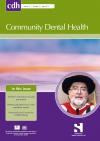Community Dental Health

- Cover Date:
- June 2015
- Print ISSN:
- 0265 539X
- Vol:
- 32
- Issue:
- 2
Caries experience among Romanian schoolchildren: prevalence and trends 1992-2011
© BASCD 2015 doi:10.1922/CDH_3516Baciu05
Caries experience among Romanian schoolchildren: prevalence and trends 1992-2011
D. Baciu, I. Danila, C. Balcos, J.E. Gallagher and E. Bernabé
Objectives: To assess the caries experience of 6-8- and 11-13-year-olds in Romania and to compare their caries levels with those from a previous study conducted in 1992. Methods: A cross-sectional pathfinder survey was conducted in five major cities of Romania (Iasi, Timisoara, Cluj-Napoca, Tirgu Mures and the capital, Bucharest) in 2011. Cities were purposively chosen for comparability with the 1992 study. Children were clinically examined by one trained dental examiner using the International Caries Detection and Assessment System (ICDAS II). Results: Among the 548 6-8-year-olds, 84.3% had caries experience (82.7% when carious lesions at stages 1-2 were excluded) with mean d1-6mft and d3-6mft of 4.76 (sd 3.46) and 4.43 (sd 3.35) respectively. Among the 592 11-13-year-olds, 83.1% had caries experience (76% when carious lesions at stages 1-2 were excluded) with mean D1-6MFT and D3-6MFT of 4.52 (sd 4.01) and 3.39 (sd 3.35) respectively. Advanced carious lesions were the main contributors to children’s caries experience. There were significant differences by cities, with the lowest caries levels seen in Bucharest. High caries levels have persisted in Romania over the last decades in spite of a small but significant decrease in d3-6mft and D3-6MFT values between 1992 and 2011. Variations in caries trends were found by citiy. Conclusion: These findings show that high caries levels still exist among schoolchildren in the five cities included in the study. Romania has not yet achieved the WHO target for 2000 of an average DMFT lower than 3 at 12 years of age.
Key words: dental caries, Romania, child, prevalence, trends
- Article Price
- £15.00
- Institution Article Price
- £
- Page Start
- 93
- Page End
- 97
- Authors
- D. Baciu, I. Danila, C. Balcos, J.E. Gallagher, E. Bernabé
Articles from this issue
- Title
- Pg. Start
- Pg. End
- Dentists’ knowledge of oral health during pregnancy: a review of the last 10 years’ publications
- 77
- 82
- A pilot project to improve the oral health of orphans and of the elderly in residential care in Constanta, Romania
- 89
- 92
- The association between parents’ perceived social norms for toothbrushing and the frequency with which they report brushing their child’s teeth
- 98
- 103
- Are Stage of Change constructs relevant for subjective oral health in a vulnerable population?
- 111
- 116
